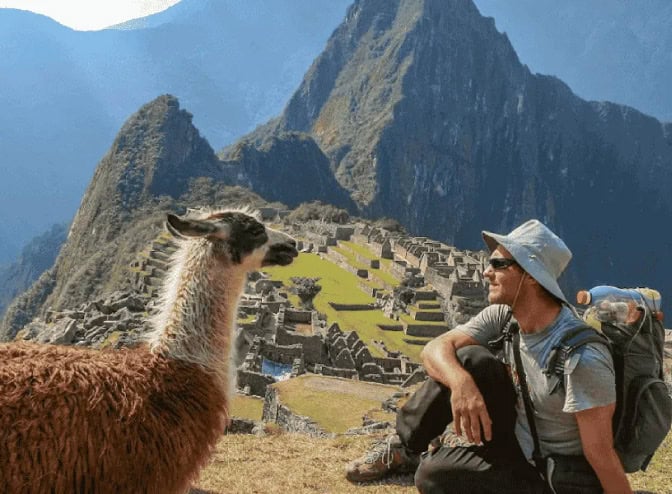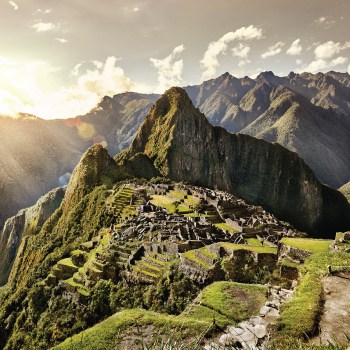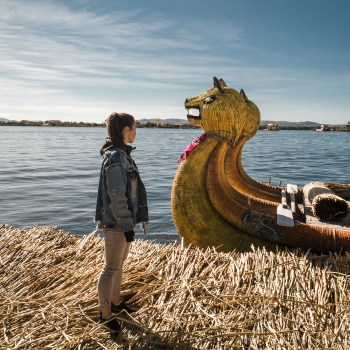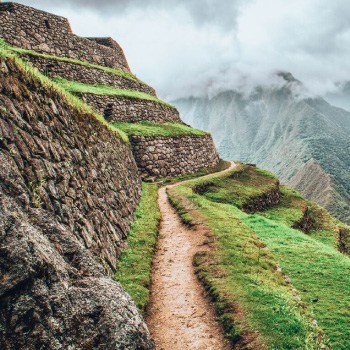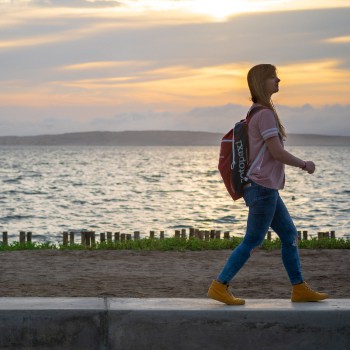Pacaya Samiria National Reserve covers over two million hectares of northern Peru and is one of the largest protected areas in the country. It is located between the Mariñon River to the north and the Ucayaly River to the south. These two rivers merge into the Amazon further east, giving the reserve its triangular shape. Due to its low altitude in the Amazon basin, it is the most extensive floodable zone in the whole South American rainforest.
The reserve was created in 1982 with the aim of giving protection to the vast amounts of plants and animals in the region. This conservation has been greatly helped by the efforts of many of the park’s 100,000 inhabitants. Human settlement consists of both indigenous tribes and outsiders. The main ethnic groups in the area include the Cucama-Cucamilla, Kiwcha, Shipibo Conibo, Shiwulu and Kacha Edze peoples.
To visit Pacaya Samiria National Reserve is to experience something special. Pink river dolphins, playful monkeys, incredible flora, beautiful sunsets reflecting on the still waters – a trip to the “jungle of mirrors” is sure to leave you with a profound appreciation of the natural gifts that the northern selva has to offer.
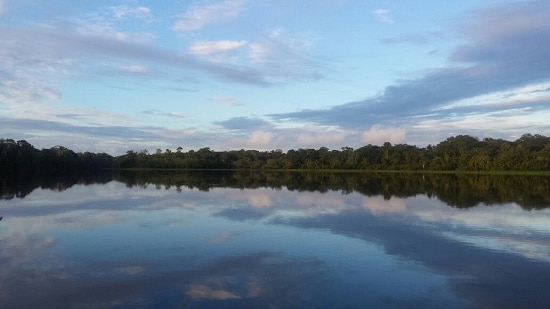
Pacaya Samiria National Reserve
Wildlife
Pacaya Samiria National Reserve provides a natural habitat for over one third of the all the species registered across the entire amazon rainforest. With five hundred species of birds and twice that amount in vertebrates, it is a wonderful location for those wishing to see plenty of animals during their stay in the jungle.
Large mammals such as the puma, jaguar, tapir, collared peccary and red brocket deer roam the dry lands of the forest, while endangered primates like the red-faced and white bellied spider monkeys can be seen taking refuge here. The park is also home to the anaconda and poisonous Jergon snake, among many more.
Much of the wildlife in Pacaya Samiria National Reserve is typical of a forest which experiences annual flooding. There are over 250 types of fish, among which the paiche, sailfin catfish and Jau catfish are in need of protection. The yellow-spotted river turtle and twist-neck turtle are also present in the waters, and there has been a huge human effort in recent years to gather their eggs and allow them the proper incubation time, thus increasing their chances of survival.
You are likely to see caimans in the long grasses surrounding lagoons, while aquatic birds in the region include the great white egret, cocoa heron, snake bird and Jabiru stork.
Pink River Dolphin
Perhaps one of the most iconic features of these parts is the pink river dolphin. Also known as the Amazon river dolphin or “Boto”, this freshwater mammal inhabits the waters of Pacaya Samiria National Reserve and never ceases to amaze onlookers as they catch a glimpse of its distinctive pink body flirting with the water’s surface.
Although the pink dolphin is the largest river dolphin species in the world, it is still considered an endangered animal. Conservationists are working tirelessly to ensure its survival in its natural habitat. To experience the boto up close is both a pleasure and a privilege, and a highlight of many who visit Pacaya Samiria National Reserve.
The grey tucuxi dolphin is also present in the area. This species is smaller than the pink dolphin and tends to navigate the rivers in a group. Whereas the boto only gives brief flashes of its body, the tucuxi can be seen to emerge fully above the water.

Pink Dolphn Pacaya Samiria National Reserve
Flora
Boasting over one thousand species of plants, Pacaya Samiria National Reserve is a heartland of wild and wonderful flora. Prominent among the various flowers is the orchid, of which there are twenty two species. The palm tree is dotted throughout the reserve, as are the mahogany, cedar, tornillo and “Dragon’s Blood” trees.
Many of the plants are a good source of nutrition with others having important medicinal functions. Cures for fever, diarrhea, headaches, muscular pain and snakebites, to name but a few, have been discovered over many years through trial and error using many of the wild plants of the jungle.
Activities
There are a number of activities that you can enjoy in Pacaya Samiria National Reserve. These can vary from one lodge to another but, in general, tend to be more or less the same.
There are wonderful opportunities for swimming with pink river dolphins. The sheer excitement is unforgettable as you share the water with these amazing creatures. Although they tend to leave you alone, the thrill is no less electrifying as you see their light pink skin surface around you. For those wishing to stay dry, admiring the dolphins from the boat can be equally as enjoyable an activity.
Searching for caimans as night descends upon the jungle is a highlight for many visitors. Not only is it fascinating to see these creatures in the long grasses by the water, but the peace and tranquility of the setting creates an atmosphere like no other. As the sun sets and the skies change color, looking across the water gives you a true appreciation of why Pacaya Samiria National Reserve is known as the jungle of mirrors.
If you are planning on spending a few days here, you are likely to set out on a number of jungle trails. Here, you will encounter various plants and trees, each one with its own unique function. Learning about their medicinal and nutritional values, as well as the various other benefits that they have, is certainly an interesting education and gives many visitors a different perspective on the jungle as an important resource for humanity.
Taking a nighttime boat ride introduces you to a different side of Pacaya Samiria National Reserve, appealing to all the senses rather than solely the visual spectacle. Here you can embrace the mysticism of the forest as your imagination takes over. This heightened sensory experience is greatly boosted by the incredible jungle symphony. Listening to the melodic cadences and patterns created by the birds and animals, hidden in their world of darkness, is as close to a heavenly moment as many will ever experience.
The flooded forest provides excellent opportunities for fishing, and many groups try their luck with piranhas. The South American fish, famous for its sharp teeth and widely-documented fondness for eating animal flesh, is a popular catch among locals, and visiting groups can often be rewarded for their hard work with a tasty lunch!
Wet and Dry Season
Due to Pacaya Samiria National Reserve’s seasonal flooding, there is a significant difference between visiting in the wet and dry season.
Although the park can be visited at any time of year, you can expect to see less wildlife in the dry season (April – November), and creeks and lakes will be smaller. There tend to be more insects around and travelling by boat is often a slower process. On the plus side, you can expect hot, dry days and certain islands that are not accessible at other times of the year can be visited.
When the waters rise in the wet season (December – March), there is a much greater animal density on the dry land. The increased volume of water makes it easier to travel around by boat and there are more chances to partake in water-related activities. You must, however, be prepared for a downpour at any time.
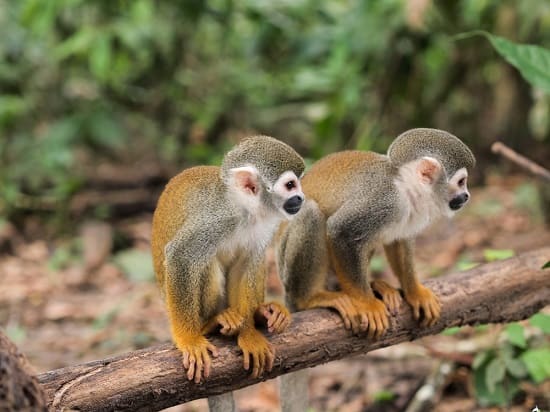
Pacaya Samiria National Reserve – Monkeys
How to get to Pacaya Samiria National Reserve
The most popular way of accessing the reserve is by flying to Iquitos, which is about an hour and a half by plane from Lima. Many lodges have offices here, from which you can be transferred by land to the smaller town of Nauta, about two hours away. Most groups board a motorized canoe at this point, continuing for approximately three hours to their jungle lodge.
Iquitos
A hot, loud, vibrant centre of activity, Iquitos claims the status as the largest city in the world that cannot be accessed by road. It was famous and extremely wealthy throughout the late nineteenth and early twentieth centuries for its exportation of rubber. Following the collapse of this industry, the city experienced a time of great depression.
Today, Iquitos is thriving once again through tourism, and the exportation of timber, petroleum and Brazil nuts. Walking around the centre, you will be blown away by the noise of motorbikes and motor taxis doing the rounds. Once you accept and embrace this, you will learn to enjoy the madness that the city offers.
Locals are friendly and always happy to talk with you. The market area of Belen is bustling, while there are some beautiful hotels along the river port. We recommend at least one night to experience Iquitos before escaping to the peaceful Pacaya Samiria National Reserve.
Lodges
Jungle lodges are wonderful places to guide you into your night’s slumber. Hearing the forest at night is as peaceful as it is mysterious. Emerging in the morning to be greeted by the virgin rainforest is simply a pleasure.
The lodges are in keeping with the natural environment. They are made from wood and most are limited to only a certain amount of electricity per night. Showers and toilets are generally provided in the rooms. The bug screen windows keep most of the insects out, while beds are surrounded by mosquito nets.
In terms of food, most lodges include breakfast, lunch and dinner in their jungle packages. Cooking facilities are quite basic but most visitors are generally satisfied with the standard of cuisine.
Clothing and Extras
In the jungle, you need to account for the humid weather, insects and possibility of rainfall. Therefore, light colors and materials are ideal. A white long-sleeved office shirt and gringo pants or three-quarter length shorts are a good example of what you can wear. It is likely that your clothes may get wet during the day so you should always have dry garments kept aside for your lodge at night. Most operators will provide you with boots and ponchos but you should always check this prior to leaving. A hat and sunglasses are optional but can be very useful.
Aside from clothing, deet-based insect repellent is essential. It is no harm to be stocked up with a torch and toilet paper, even though most lodges provide these. A book or playing cards are also a good idea for nighttime entertainment.
Medication
Pacaya Samiria National Reserve is considered a high-risk zone and some lodges require that you have proof of having had certain vaccines, such a yellow fever. Most people take anti-malarial tablets before, during and after their jungle trip. It is extremely important to consult a medical professional prior to travelling to this area.
Basic medication such as headache and diarrhea tablets are also highly recommended as you will be spending time in a remote region.
Suitable For What Ages
The Amazon Jungle is a special place and, for both children and adults, it can instill a lifelong love of nature. However, as a general guideline, it is probably more suited to children above the age of seven. It is also worth keeping in mind that you are far removed from a medical clinic should young children become ill.
If your worries lie at the opposite end of the scale, there is no need to fret. Lodges can be flexible with their activities and, as long as you have a sense of adventure, you will love Pacaya Samiria National Reserve regardless of what age you are.

